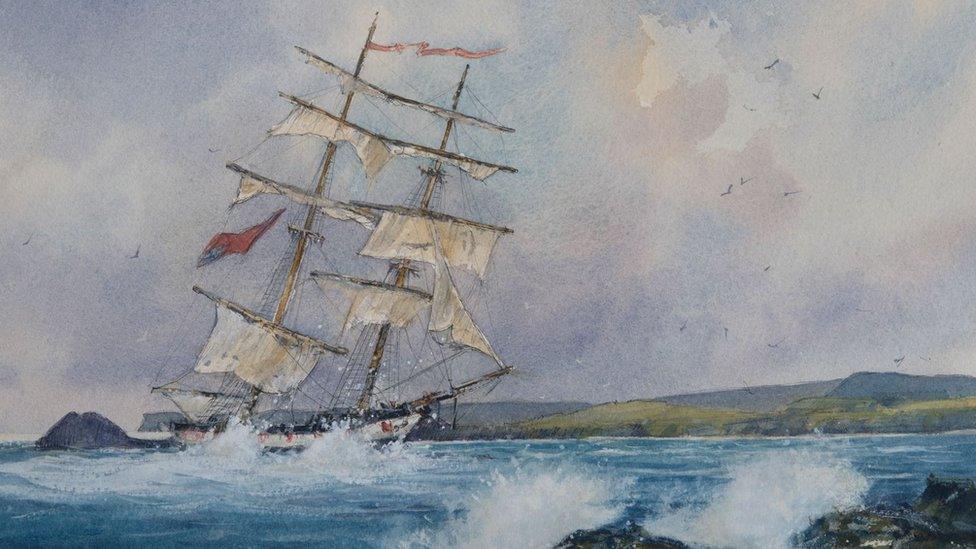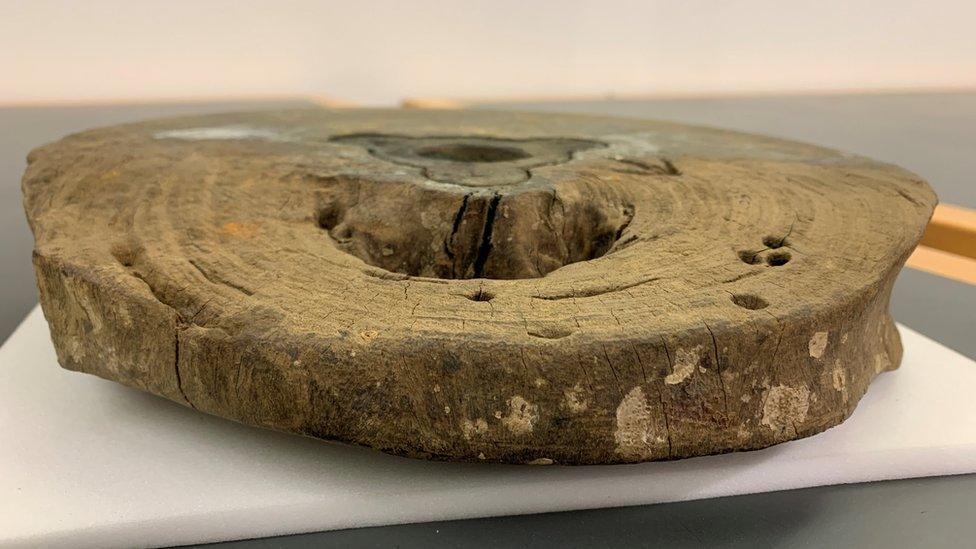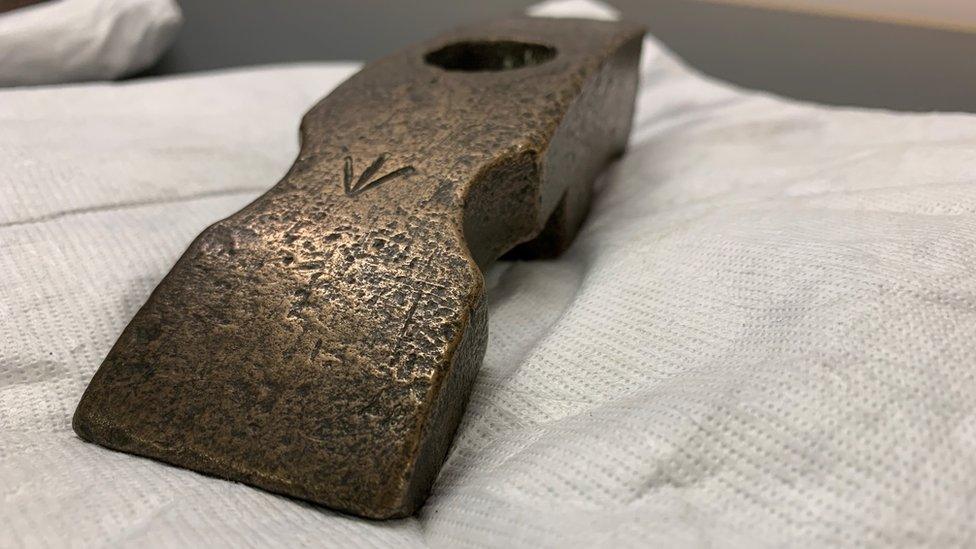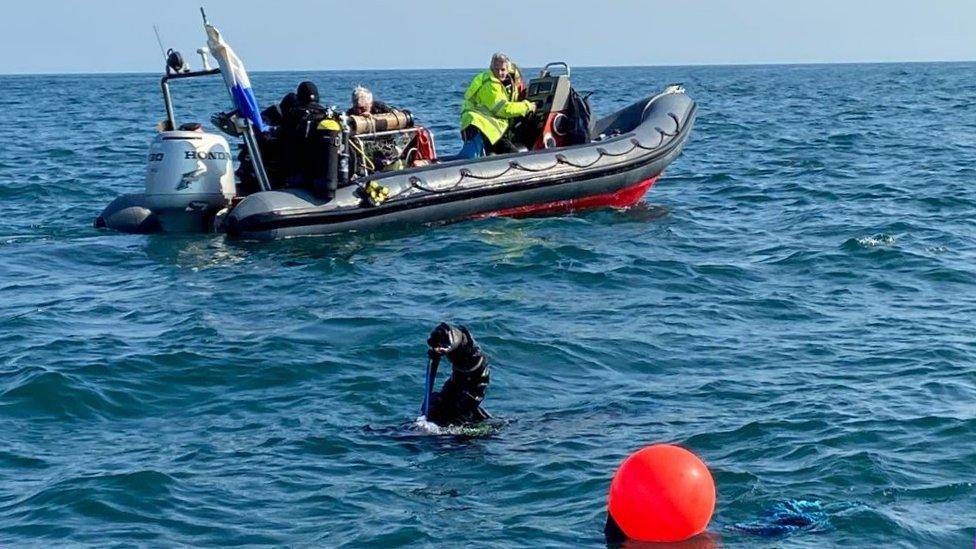HMS Racehorse: Exhibition sheds light on historic Manx shipwreck
- Published

HMS Racehorse was wrecked off Langness on 14 December 1822
There are more than 2,000 shipwrecks recorded in the waters surrounding the Isle of Man but one has special place in maritime history.
The loss of HMS Racehorse off Langness in December 1822 was a catalyst for the creation of the RNLI.
However, the location of the wreck of the Royal Navy vessel itself has only recently been rediscovered.
Now the story of the ill-fated ship has been brought to life by an exhibition complete with 3D digital footage.
HMS Racehorse was on route to Douglas to pick up the crew of another navy ship HMS Vigilant, which had foundered on Conister Rock, when a navigational error sealed the fate of the vessel.
Mistaking the lights of Castletown for Douglas Harbour the vessel ended up on the rocks of the Skerranes, off Langness in the south of the island.
Items found at the HMS Racehorse wreck site are now on display in Castletown
About 100 members of the ship's crew reached the shore safely but the rescue boat was swamped by water on its final trip, killing three men from Castletown.
The deaths proved to be the catalyst for the founding of the RNLI, after Manx resident Sir William Hillary petitioned for a national lifesaving institution.
Apart from a salvage operation 20 years after the sinking, the wreck of HMS Racehorse lay relatively undisturbed for the next 130 years, until 1968 when a group of divers from the Isle of Man Sub-Aqua Club set out to find it.

A team spent five years excavating the wreck site in the 1980s
Brian King was among the divers who found the wreck and helped with further excavations.
He said he has "never forgotten" seeing the remains of the vessel for the first time.
"I remember going over the top of some rocks and looking down and seeing a pair of map dividers lying there, bronze map dividers, and the feeling when I saw that," he recalled.
At the time, the divers collected the artefacts lying on the surface so they could not be taken by other divers as souvenirs and handed them to the Manx Museum, Mr King said.

Brian King was part of the team of divers that discovered the wreck in 1968
The wreck was declared of historical interest and the club was advised to buy the site to offer it added protection.
But it wasn't until the 1980s that an operation to excavate more remains of the vessel from the "massive jumble of rocks and seaweed" was launched by the club, Mr King said.
That project lasted more than five years, with about 300 items excavated, external and donated to the Manx Museum.

While the body of the ship no longer exists, items crucial to its mechanism do
Allison Fox, curator of archaeology for Manx National Heritage, said they included cannon balls and musket shot, and blocks and pullies that were integral to a sailing ship, as well as practical day-to-day items like shoes and cutlery.
Ms Fox said: "We think about the military aspect of these ships, but the ships were the homes of the sailors for weeks, sometimes months on end, so of course we're going to find those everyday personal items as well."
In the intervening years, the story of HMS Racehorse and its fate once again largely faded from memory on the island.
But with commemorations being planned to mark the 200th anniversary of the shipwreck approaching, it was decided that it should once again be found.

Some of the items recovered bear the Royal Navy arrowhead mark
Members of the Sub-Aqua Club again set about searching for the wreck site.
Club chairman club Leigh Morris said after two years of looking, the "stars aligned" in April this year when the wreck site was found in an area which is a "lattice" of deep natural rock gullies.

A team of divers rediscovered the wreck site in April this year
Mr Morris said the amount of material still there meant it was "really important that the wreck site is protected".
"We're very conscious that we are the custodians of this really important site," he added.
As part of that rediscovery 3D models of the wreck site were created and released online, allowing people to access and explore the site digitally for the first time.
Divers have been exploring the wreck site of the HMS Racehorse
Jon Chamberlain of the University of Essex, who was behind that project, said it was a "very touching story to be part of".
An exhibition featuring some of the items recovered from the wreck and the 3D modelling is on display at Castletown Civic Hall until 30 December.

Why not follow BBC Isle of Man on Facebook, external and Twitter, external? You can also send story ideas to IsleofMan@bbc.co.uk, external
Related topics
- Published14 December 2022
